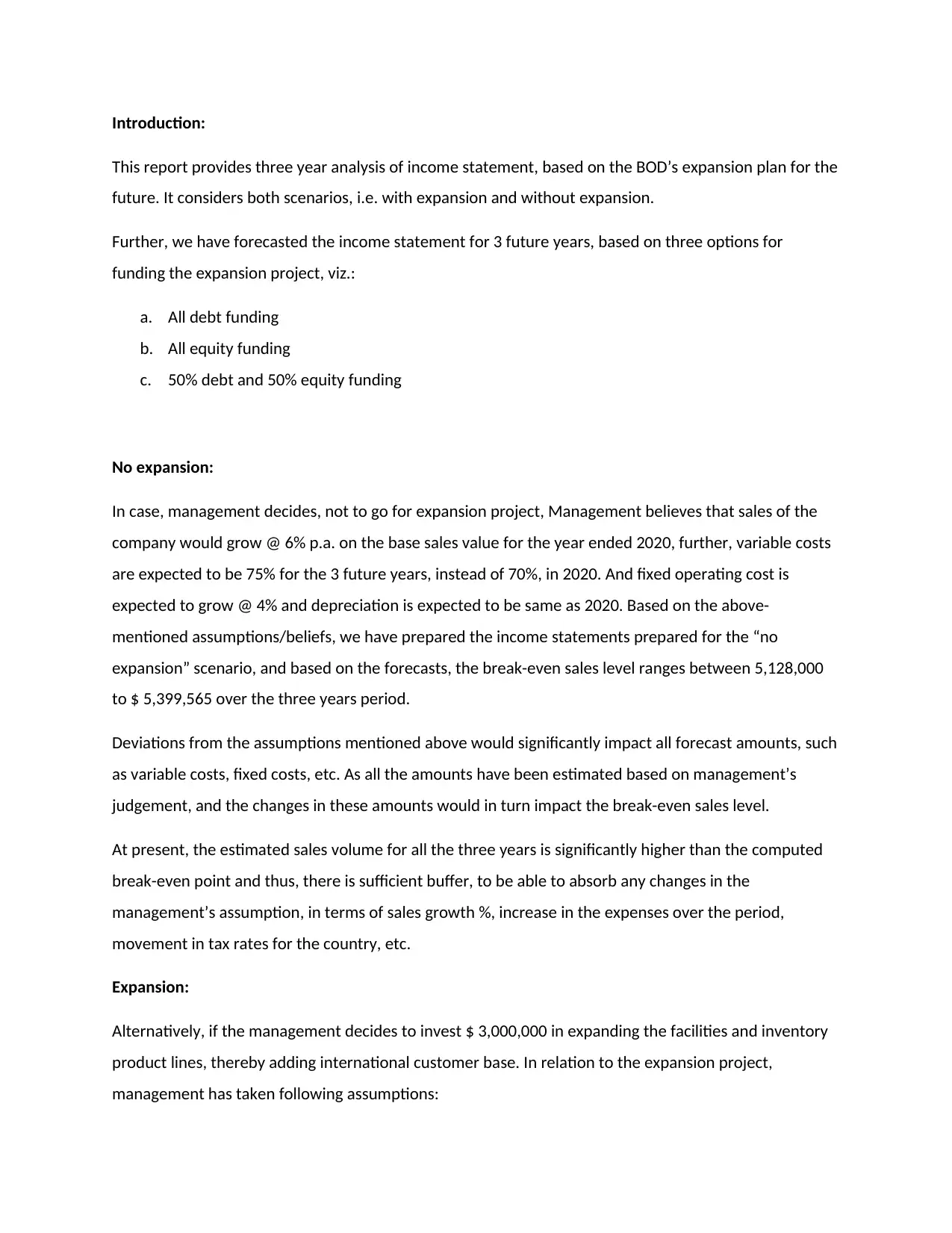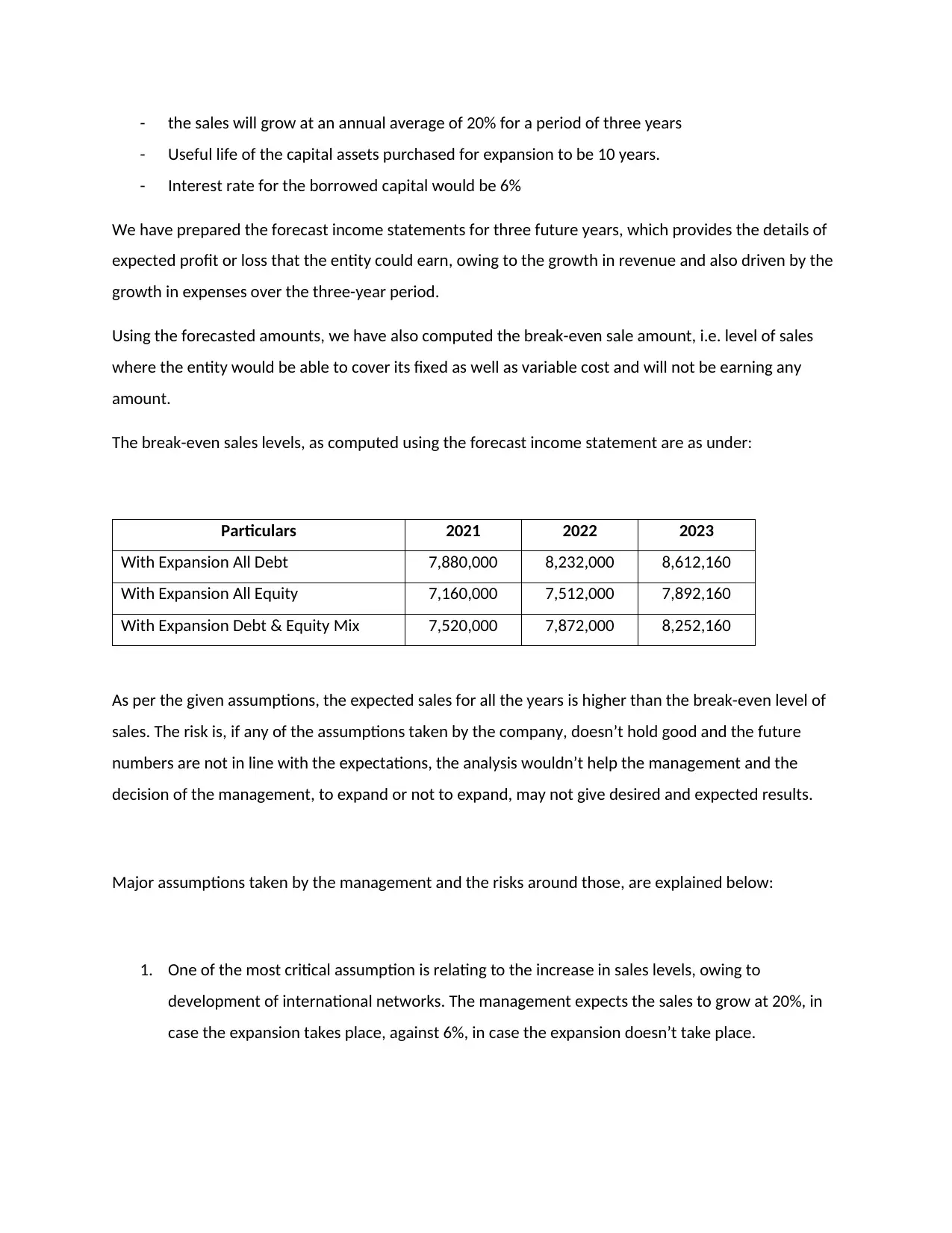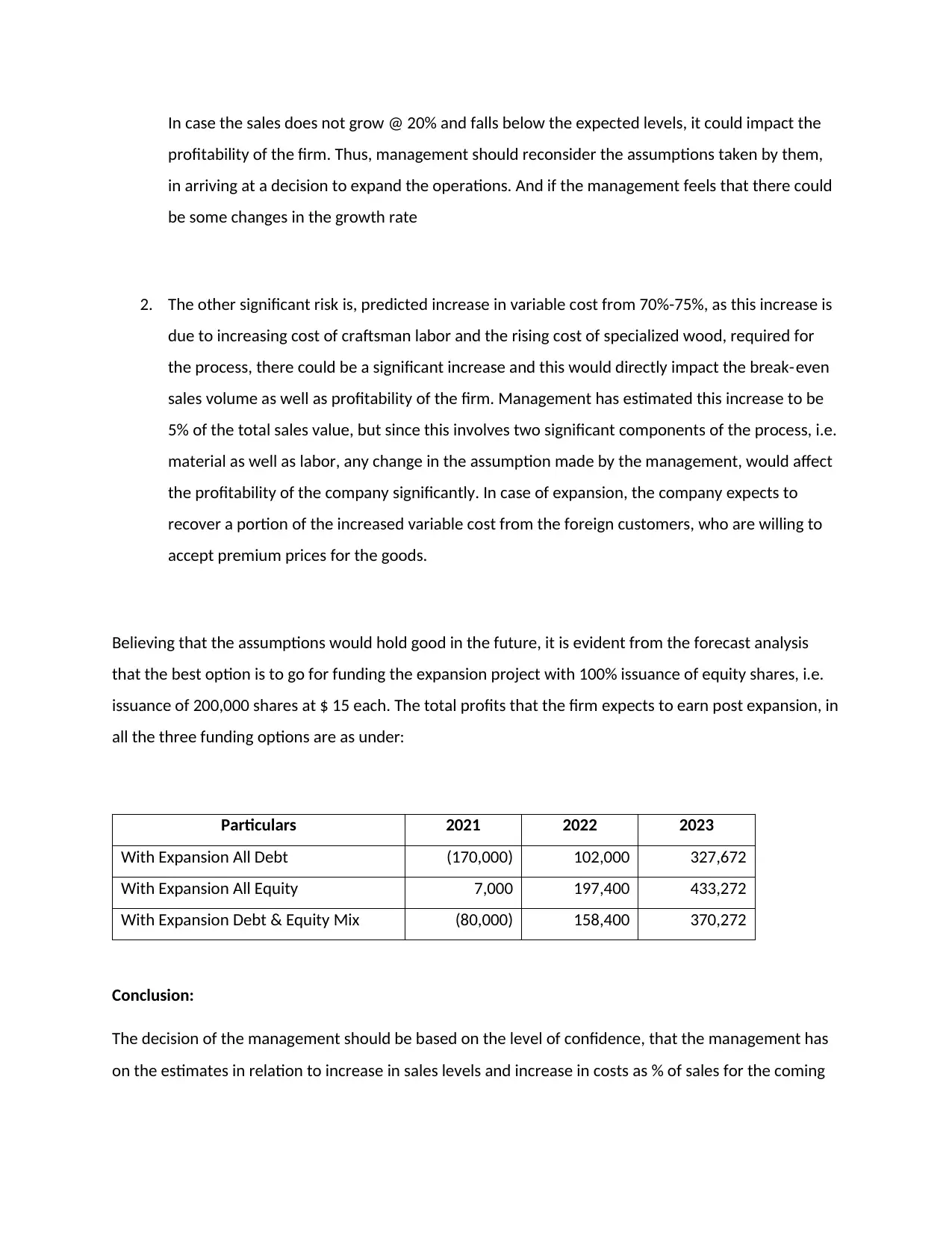Income Statement Analysis and Forecast: Expansion Plan Report
VerifiedAdded on 2022/10/10
|4
|1134
|15
Report
AI Summary
This report presents a three-year income statement analysis based on a company's expansion plan, considering scenarios with and without expansion. It forecasts future income statements under three funding options: all debt, all equity, and a mix of both. The analysis includes break-even sales level calculations and discusses the impact of various assumptions, such as sales growth and cost changes, on profitability. The report assesses the risks associated with the expansion, particularly concerning sales growth and variable costs, and recommends an equity-based financing approach due to its projected higher earnings. The conclusion emphasizes the importance of management's confidence in the estimates and advises on the optimal financing strategy based on the company's risk assessment and financial goals. The report highlights the importance of break-even analysis and the sensitivity of financial projections to changes in key assumptions.

Introduction:
This report provides three year analysis of income statement, based on the BOD’s expansion plan for the
future. It considers both scenarios, i.e. with expansion and without expansion.
Further, we have forecasted the income statement for 3 future years, based on three options for
funding the expansion project, viz.:
a. All debt funding
b. All equity funding
c. 50% debt and 50% equity funding
No expansion:
In case, management decides, not to go for expansion project, Management believes that sales of the
company would grow @ 6% p.a. on the base sales value for the year ended 2020, further, variable costs
are expected to be 75% for the 3 future years, instead of 70%, in 2020. And fixed operating cost is
expected to grow @ 4% and depreciation is expected to be same as 2020. Based on the above-
mentioned assumptions/beliefs, we have prepared the income statements prepared for the “no
expansion” scenario, and based on the forecasts, the break-even sales level ranges between 5,128,000
to $ 5,399,565 over the three years period.
Deviations from the assumptions mentioned above would significantly impact all forecast amounts, such
as variable costs, fixed costs, etc. As all the amounts have been estimated based on management’s
judgement, and the changes in these amounts would in turn impact the break-even sales level.
At present, the estimated sales volume for all the three years is significantly higher than the computed
break-even point and thus, there is sufficient buffer, to be able to absorb any changes in the
management’s assumption, in terms of sales growth %, increase in the expenses over the period,
movement in tax rates for the country, etc.
Expansion:
Alternatively, if the management decides to invest $ 3,000,000 in expanding the facilities and inventory
product lines, thereby adding international customer base. In relation to the expansion project,
management has taken following assumptions:
This report provides three year analysis of income statement, based on the BOD’s expansion plan for the
future. It considers both scenarios, i.e. with expansion and without expansion.
Further, we have forecasted the income statement for 3 future years, based on three options for
funding the expansion project, viz.:
a. All debt funding
b. All equity funding
c. 50% debt and 50% equity funding
No expansion:
In case, management decides, not to go for expansion project, Management believes that sales of the
company would grow @ 6% p.a. on the base sales value for the year ended 2020, further, variable costs
are expected to be 75% for the 3 future years, instead of 70%, in 2020. And fixed operating cost is
expected to grow @ 4% and depreciation is expected to be same as 2020. Based on the above-
mentioned assumptions/beliefs, we have prepared the income statements prepared for the “no
expansion” scenario, and based on the forecasts, the break-even sales level ranges between 5,128,000
to $ 5,399,565 over the three years period.
Deviations from the assumptions mentioned above would significantly impact all forecast amounts, such
as variable costs, fixed costs, etc. As all the amounts have been estimated based on management’s
judgement, and the changes in these amounts would in turn impact the break-even sales level.
At present, the estimated sales volume for all the three years is significantly higher than the computed
break-even point and thus, there is sufficient buffer, to be able to absorb any changes in the
management’s assumption, in terms of sales growth %, increase in the expenses over the period,
movement in tax rates for the country, etc.
Expansion:
Alternatively, if the management decides to invest $ 3,000,000 in expanding the facilities and inventory
product lines, thereby adding international customer base. In relation to the expansion project,
management has taken following assumptions:
Paraphrase This Document
Need a fresh take? Get an instant paraphrase of this document with our AI Paraphraser

- the sales will grow at an annual average of 20% for a period of three years
- Useful life of the capital assets purchased for expansion to be 10 years.
- Interest rate for the borrowed capital would be 6%
We have prepared the forecast income statements for three future years, which provides the details of
expected profit or loss that the entity could earn, owing to the growth in revenue and also driven by the
growth in expenses over the three-year period.
Using the forecasted amounts, we have also computed the break-even sale amount, i.e. level of sales
where the entity would be able to cover its fixed as well as variable cost and will not be earning any
amount.
The break-even sales levels, as computed using the forecast income statement are as under:
Particulars 2021 2022 2023
With Expansion All Debt 7,880,000 8,232,000 8,612,160
With Expansion All Equity 7,160,000 7,512,000 7,892,160
With Expansion Debt & Equity Mix 7,520,000 7,872,000 8,252,160
As per the given assumptions, the expected sales for all the years is higher than the break-even level of
sales. The risk is, if any of the assumptions taken by the company, doesn’t hold good and the future
numbers are not in line with the expectations, the analysis wouldn’t help the management and the
decision of the management, to expand or not to expand, may not give desired and expected results.
Major assumptions taken by the management and the risks around those, are explained below:
1. One of the most critical assumption is relating to the increase in sales levels, owing to
development of international networks. The management expects the sales to grow at 20%, in
case the expansion takes place, against 6%, in case the expansion doesn’t take place.
- Useful life of the capital assets purchased for expansion to be 10 years.
- Interest rate for the borrowed capital would be 6%
We have prepared the forecast income statements for three future years, which provides the details of
expected profit or loss that the entity could earn, owing to the growth in revenue and also driven by the
growth in expenses over the three-year period.
Using the forecasted amounts, we have also computed the break-even sale amount, i.e. level of sales
where the entity would be able to cover its fixed as well as variable cost and will not be earning any
amount.
The break-even sales levels, as computed using the forecast income statement are as under:
Particulars 2021 2022 2023
With Expansion All Debt 7,880,000 8,232,000 8,612,160
With Expansion All Equity 7,160,000 7,512,000 7,892,160
With Expansion Debt & Equity Mix 7,520,000 7,872,000 8,252,160
As per the given assumptions, the expected sales for all the years is higher than the break-even level of
sales. The risk is, if any of the assumptions taken by the company, doesn’t hold good and the future
numbers are not in line with the expectations, the analysis wouldn’t help the management and the
decision of the management, to expand or not to expand, may not give desired and expected results.
Major assumptions taken by the management and the risks around those, are explained below:
1. One of the most critical assumption is relating to the increase in sales levels, owing to
development of international networks. The management expects the sales to grow at 20%, in
case the expansion takes place, against 6%, in case the expansion doesn’t take place.

In case the sales does not grow @ 20% and falls below the expected levels, it could impact the
profitability of the firm. Thus, management should reconsider the assumptions taken by them,
in arriving at a decision to expand the operations. And if the management feels that there could
be some changes in the growth rate
2. The other significant risk is, predicted increase in variable cost from 70%-75%, as this increase is
due to increasing cost of craftsman labor and the rising cost of specialized wood, required for
the process, there could be a significant increase and this would directly impact the break-even
sales volume as well as profitability of the firm. Management has estimated this increase to be
5% of the total sales value, but since this involves two significant components of the process, i.e.
material as well as labor, any change in the assumption made by the management, would affect
the profitability of the company significantly. In case of expansion, the company expects to
recover a portion of the increased variable cost from the foreign customers, who are willing to
accept premium prices for the goods.
Believing that the assumptions would hold good in the future, it is evident from the forecast analysis
that the best option is to go for funding the expansion project with 100% issuance of equity shares, i.e.
issuance of 200,000 shares at $ 15 each. The total profits that the firm expects to earn post expansion, in
all the three funding options are as under:
Particulars 2021 2022 2023
With Expansion All Debt (170,000) 102,000 327,672
With Expansion All Equity 7,000 197,400 433,272
With Expansion Debt & Equity Mix (80,000) 158,400 370,272
Conclusion:
The decision of the management should be based on the level of confidence, that the management has
on the estimates in relation to increase in sales levels and increase in costs as % of sales for the coming
profitability of the firm. Thus, management should reconsider the assumptions taken by them,
in arriving at a decision to expand the operations. And if the management feels that there could
be some changes in the growth rate
2. The other significant risk is, predicted increase in variable cost from 70%-75%, as this increase is
due to increasing cost of craftsman labor and the rising cost of specialized wood, required for
the process, there could be a significant increase and this would directly impact the break-even
sales volume as well as profitability of the firm. Management has estimated this increase to be
5% of the total sales value, but since this involves two significant components of the process, i.e.
material as well as labor, any change in the assumption made by the management, would affect
the profitability of the company significantly. In case of expansion, the company expects to
recover a portion of the increased variable cost from the foreign customers, who are willing to
accept premium prices for the goods.
Believing that the assumptions would hold good in the future, it is evident from the forecast analysis
that the best option is to go for funding the expansion project with 100% issuance of equity shares, i.e.
issuance of 200,000 shares at $ 15 each. The total profits that the firm expects to earn post expansion, in
all the three funding options are as under:
Particulars 2021 2022 2023
With Expansion All Debt (170,000) 102,000 327,672
With Expansion All Equity 7,000 197,400 433,272
With Expansion Debt & Equity Mix (80,000) 158,400 370,272
Conclusion:
The decision of the management should be based on the level of confidence, that the management has
on the estimates in relation to increase in sales levels and increase in costs as % of sales for the coming
⊘ This is a preview!⊘
Do you want full access?
Subscribe today to unlock all pages.

Trusted by 1+ million students worldwide

years. If the management feels that the growth in sales as well as costs would be in line with the
expectations, it could go for the expansion plan.
And, as it is evident from the table above that the earnings after tax in the option with expansion using
all equity, is higher as compared to other financing options viz. 50% debt and 100% debt, management
should opt for financing the expansion plan using equity as the source of funds.
expectations, it could go for the expansion plan.
And, as it is evident from the table above that the earnings after tax in the option with expansion using
all equity, is higher as compared to other financing options viz. 50% debt and 100% debt, management
should opt for financing the expansion plan using equity as the source of funds.
1 out of 4
Related Documents
Your All-in-One AI-Powered Toolkit for Academic Success.
+13062052269
info@desklib.com
Available 24*7 on WhatsApp / Email
![[object Object]](/_next/static/media/star-bottom.7253800d.svg)
Unlock your academic potential
Copyright © 2020–2025 A2Z Services. All Rights Reserved. Developed and managed by ZUCOL.



